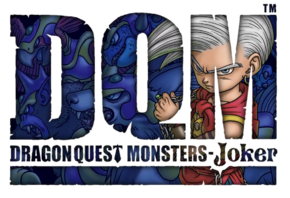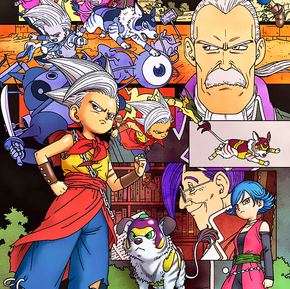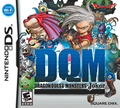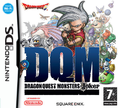Dragon Quest Monsters: Joker: Difference between revisions
Antiyonder (talk | contribs) No edit summary |
No edit summary |
||
| Line 20: | Line 20: | ||
|input = | |input = | ||
}} | }} | ||
'''Dragon Quest Monsters: Joker''' is the | '''Dragon Quest Monsters: Joker''' is the fourth game in the {{DQMSeries}} and the first game to be in 3D, taking inspiration from {{DQ8}} in the use of cel-shaded graphics. It began the ''Joker'' trilogy, which saw a tremendous renovation to the gameplay and tone of the series. | ||
==Setting== | |||
The game takes place in the region known as the [[Green Bays]] archipelago, consisting of seven islands: | |||
''Joker'' | |||
== | |||
The game takes place in the region known as the [[Green Bays]] archipelago, consisting of seven islands | |||
*[[Domus Isle]] - island holding the Jokers' GP Tournament. | *[[Domus Isle]] - island holding the Jokers' GP Tournament. | ||
*[[Infant Isle]] - island with a great tree at the center; it is inhabited by weak monsters. | *[[Infant Isle]] - island with a great tree at the center; it is inhabited by weak monsters. | ||
| Line 43: | Line 31: | ||
*[[Fert Isle]] - jungle island; where the jail is located. | *[[Fert Isle]] - jungle island; where the jail is located. | ||
A sea scooter is used to travel from one island to another, with specific paths defined for every couple of jetties. However, the main character may notice uncharted islands beyond some of the main islands. The chances for this are completely random and aren't located on the main map. | A sea scooter is used to travel from one island to another, with specific paths defined for every couple of jetties. However, the main character may notice uncharted islands beyond some of the main islands. The chances for this are completely random and aren't located on the main map. | ||
==Characters== | |||
*[[Hero (Dragon Quest Monsters: Joker)|Hero]] | |||
*[[Solitaire]] | |||
*[[Dr. Snap]] | |||
*[[Warden Trump]] | |||
*[[Incarnus]] | |||
==Gameplay== | |||
210 monsters are available to recruit and synthesize. The battle system itself is similar to previous ''Monsters'' games in that the player controls up to three monsters that make up the party, and can issue them direct orders or set them to one of 5 AI settings. The main character does not directly participate in battles except for when the player uses items. The finer details have changed as the series entered the 3D era. | |||
==New Features & system alterations== | |||
*Monsters now all have a rank associated with them: F, E, D, C, B, A, S, and X. The ranks give an idea of how quickly the monster's stats will grow, not necessarily the maximum limit, and how hard they are to find in the wild/synthesize. | |||
*The traditional monster families have returned after the radical departure seen in {{DQMCH}}, being the [[Slime family|Slime]], [[Beast family|Beast]], [[Demon family|Demon]], [[Dragon family|Dragon]], [[Material family|Material]], [[Nature family|Nature]], and [[Undead family|Undead]] families, along with the new plot-focused [[Incarnus|Incarni]] family. | |||
:*Several families seen in the first two games have been merged with others, such as several members of the [[Bird family|Bird]] and [[Bug family|Bug]] families being grouped in the Nature family. Most notable is that the [[??? family]] which contained several Archfiends of past mainline titles has been totally dissolved, with the members being added to the other families. | |||
*[[Monster synthesis]] has replaced the older [[monster breeding]] system. | |||
*Monsters no longer learn skills and spells upon leveling up, and instead utilize skillsets identical to those seen in ''VIII''. Skill points are obtained upon reaching select levels, and are used to unlock abilities within the skillsets. | |||
*A maximum stat cap has been given to each monster breed, meaning it is no longer possible to breed monsters with 999 in every stat. | |||
*The [[Zam]] family of spells was created, representing the element of darkness. | |||
*A fourth tier of attack spells had been created, addressing the criticisms that offensive magic was underpowered compared to attack skills in the previous three games | |||
:*The wisdom stat now increases the power of attack and healing magic. | |||
*Random encounters have been abolished and enemies appear on-screen for the first time in the ''Dragon Quest'' series as a whole. The Hero can obtain the [[whistle]] skill to instantly start a battle on the overworld. | |||
*Food-based recruitment has been retired for [[monster scouting]], informing players of precisely what chance they have to obtain a monster when used. | |||
*A reserve party of up to three monsters can be taken along on an adventure, bringing the total amount the player can have to six. These reserve monsters can only be switched in and out of the party outside of battle. | |||
*The player could battle friends over the Nintendo wi-fi connection. Upon logging into the game's server, the player's team is ranked and the DS then downloads a set of opponents to battle. The battles are against the monster teams of higher and higher ranked other players, and for each victorious battle the player is awarded a rare item or a monster. These rewards changed daily and could range from unexciting items to rare monsters such as [[liquid metal slime]]s. The player could only fight one set of opponents and get a reward once each day. | |||
== | ==Rare monsters== | ||
There are three monsters, [[Trode]], [[Leopold]], and [[Empyrea]], that can not be scouted or synthesized in the normal game. The only way to get Trode was to visit a DS Station in Japan or to use a cheating device. Players will receive a Leopold when they have collected all of the different possible skillsets in the library. The only way to get Empyrea is to collect all 210 monsters in the library. Leopold and Empyrea are required in order to synthesize the [[Ace of spades]] and [[Wildcard]]. | |||
==Development== | |||
Production on the title began shortly after the Nintendo DS was announced. From the beginning, ''Monsters'' series producer [[Taichi Inuzuka]] wanted to give the game a slightly more serious "adult" feeling that would appeal to younger players who had grown out of Pokemon could appreciate.<ref>犬塚: 小学生、中学生って「俺は大人だぜ」みたいに、大人っぽいものへの憧れがあると思うんですよ。それに「ポケモン」シリーズを卒業したプレイヤーさんに遊んでもらいたいっていう感じでしたね。''ドラゴンクエストモンスターズ3 魔族の王子とエルフの旅 WORLD&MONSTER DATABASE interview, ISBN:978-4-08-779813-5''</ref> | |||
==Reception== | |||
The first entry in the ''Joker'' sub-series was an astounding success upon launch, reaching sales of approximately 1.5 million units compared to the 600,000 untis of ''Caravan Heart''. Series producer Taichi Inuzuka attributes the continuation of the ''Monsters'' series to the success of the game<ref>犬塚: かなりの反響もあって、この作品がきっかけでシリーズが続きました。''ドラゴンクエストモンスターズ3 魔族の王子とエルフの旅 WORLD&MONSTER DATABASE interview, ISBN:978-4-08-779813-5''</ref>, and Yuji Horii asserts that the tournaments held for the title were a significant factor in it's reception<ref>堀井: 大会もかなり開催していたよね。 | |||
犬塚: 堀井さんには、必ず決勝にゲストとして来てもらっていました! | |||
堀井: 大会が人気の一因だと思うから 「絶対出たいな」と思ってたんだよ ''ドラゴンクエストモンスターズ3 魔族の王子とエルフの旅 WORLD&MONSTER DATABASE interview, ISBN:978-4-08-779813-5''</ref>. | |||
Though a runaway financial success, ''Joker'' has received considerable criticism upon it's release and in the years since. The main points come down to the considerable difficulty curve<ref>堀井: 『DQMジョーカー 1』 は、 結構バランスがきつくて難しかったから、その反省があって、『DQMジョーカー2』はすごい甘々にしたんです (笑)。 | |||
犬塚: まあ、 堀井さんは基本的に甘くしますよね。 | |||
堀井: 僕は常にそうですね。甘々ですね(笑)。全員に最後まで楽しんで欲しいので。</ref>, the hard stat limits permanently fixed to each monster breed when all three previous titles allowed any monster to be strengthened, the removal of the [[Sizz]] family of spells, the higher number of pallet-swap monsters compared to previous games, the slow walking speed of the protagonist, and that two monsters (Trode & Empyrea) are unobtainable through normal gameplay. | |||
In spite of these issues, the ''Monsters'' series made tremendous strides forwards in both terms of gameplay sophistication and relevancy in the industry thanks to this title. | |||
==Gallery== | ==Gallery== | ||
| Line 81: | Line 82: | ||
</gallery></center> | </gallery></center> | ||
==References== | |||
<references/> | |||
{{DQMJI}} | {{DQMJI}} | ||
Latest revision as of 21:24, 5 February 2024
| Dragon Quest Monsters: Joker | |
|---|---|
 
| |
| Developer(s) | TOSE |
| Publisher(s) | Square Enix |
| Distributor(s) | AUS Ubisoft |
| Designer(s) | Yuji Horii |
| Artist(s) | Akira Toriyama |
| Composer(s) | Kōichi Sugiyama |
| Series | Dragon Quest Monsters |
| Platform(s) | Nintendo DS |
| Release date(s) | JP December 28, 2006 NA November 6, 2007 AUS March 13, 2008 EU March 14, 2008 |
| Genre(s) | Console role-playing game |
| Mode(s) | Single-player, multiplayer game |
| Rating(s) | OFLC: PG ESRB: E10+ |
Dragon Quest Monsters: Joker is the fourth game in the Dragon Quest Monsters series and the first game to be in 3D, taking inspiration from Dragon Quest VIII: Journey of the Cursed King in the use of cel-shaded graphics. It began the Joker trilogy, which saw a tremendous renovation to the gameplay and tone of the series.
Setting
The game takes place in the region known as the Green Bays archipelago, consisting of seven islands:
- Domus Isle - island holding the Jokers' GP Tournament.
- Infant Isle - island with a great tree at the center; it is inhabited by weak monsters.
- Xeroph Isle - desert island.
- Palaish Isle - private garden island.
- Infern Isle - barren island, inhabited by zombies.
- Celeste Isle - an island with two towers and some ruins.
- Fert Isle - jungle island; where the jail is located.
A sea scooter is used to travel from one island to another, with specific paths defined for every couple of jetties. However, the main character may notice uncharted islands beyond some of the main islands. The chances for this are completely random and aren't located on the main map.
Characters
Gameplay
210 monsters are available to recruit and synthesize. The battle system itself is similar to previous Monsters games in that the player controls up to three monsters that make up the party, and can issue them direct orders or set them to one of 5 AI settings. The main character does not directly participate in battles except for when the player uses items. The finer details have changed as the series entered the 3D era.
New Features & system alterations
- Monsters now all have a rank associated with them: F, E, D, C, B, A, S, and X. The ranks give an idea of how quickly the monster's stats will grow, not necessarily the maximum limit, and how hard they are to find in the wild/synthesize.
- The traditional monster families have returned after the radical departure seen in Dragon Quest Monsters: Caravan Heart, being the Slime, Beast, Demon, Dragon, Material, Nature, and Undead families, along with the new plot-focused Incarni family.
- Several families seen in the first two games have been merged with others, such as several members of the Bird and Bug families being grouped in the Nature family. Most notable is that the ??? family which contained several Archfiends of past mainline titles has been totally dissolved, with the members being added to the other families.
- Monster synthesis has replaced the older monster breeding system.
- Monsters no longer learn skills and spells upon leveling up, and instead utilize skillsets identical to those seen in VIII. Skill points are obtained upon reaching select levels, and are used to unlock abilities within the skillsets.
- A maximum stat cap has been given to each monster breed, meaning it is no longer possible to breed monsters with 999 in every stat.
- The Zam family of spells was created, representing the element of darkness.
- A fourth tier of attack spells had been created, addressing the criticisms that offensive magic was underpowered compared to attack skills in the previous three games
- The wisdom stat now increases the power of attack and healing magic.
- Random encounters have been abolished and enemies appear on-screen for the first time in the Dragon Quest series as a whole. The Hero can obtain the whistle skill to instantly start a battle on the overworld.
- Food-based recruitment has been retired for monster scouting, informing players of precisely what chance they have to obtain a monster when used.
- A reserve party of up to three monsters can be taken along on an adventure, bringing the total amount the player can have to six. These reserve monsters can only be switched in and out of the party outside of battle.
- The player could battle friends over the Nintendo wi-fi connection. Upon logging into the game's server, the player's team is ranked and the DS then downloads a set of opponents to battle. The battles are against the monster teams of higher and higher ranked other players, and for each victorious battle the player is awarded a rare item or a monster. These rewards changed daily and could range from unexciting items to rare monsters such as liquid metal slimes. The player could only fight one set of opponents and get a reward once each day.
Rare monsters
There are three monsters, Trode, Leopold, and Empyrea, that can not be scouted or synthesized in the normal game. The only way to get Trode was to visit a DS Station in Japan or to use a cheating device. Players will receive a Leopold when they have collected all of the different possible skillsets in the library. The only way to get Empyrea is to collect all 210 monsters in the library. Leopold and Empyrea are required in order to synthesize the Ace of spades and Wildcard.
Development
Production on the title began shortly after the Nintendo DS was announced. From the beginning, Monsters series producer Taichi Inuzuka wanted to give the game a slightly more serious "adult" feeling that would appeal to younger players who had grown out of Pokemon could appreciate.[1]
Reception
The first entry in the Joker sub-series was an astounding success upon launch, reaching sales of approximately 1.5 million units compared to the 600,000 untis of Caravan Heart. Series producer Taichi Inuzuka attributes the continuation of the Monsters series to the success of the game[2], and Yuji Horii asserts that the tournaments held for the title were a significant factor in it's reception[3].
Though a runaway financial success, Joker has received considerable criticism upon it's release and in the years since. The main points come down to the considerable difficulty curve[4], the hard stat limits permanently fixed to each monster breed when all three previous titles allowed any monster to be strengthened, the removal of the Sizz family of spells, the higher number of pallet-swap monsters compared to previous games, the slow walking speed of the protagonist, and that two monsters (Trode & Empyrea) are unobtainable through normal gameplay.
In spite of these issues, the Monsters series made tremendous strides forwards in both terms of gameplay sophistication and relevancy in the industry thanks to this title.
Gallery
References
- ↑ 犬塚: 小学生、中学生って「俺は大人だぜ」みたいに、大人っぽいものへの憧れがあると思うんですよ。それに「ポケモン」シリーズを卒業したプレイヤーさんに遊んでもらいたいっていう感じでしたね。ドラゴンクエストモンスターズ3 魔族の王子とエルフの旅 WORLD&MONSTER DATABASE interview, ISBN:978-4-08-779813-5
- ↑ 犬塚: かなりの反響もあって、この作品がきっかけでシリーズが続きました。ドラゴンクエストモンスターズ3 魔族の王子とエルフの旅 WORLD&MONSTER DATABASE interview, ISBN:978-4-08-779813-5
- ↑ 堀井: 大会もかなり開催していたよね。 犬塚: 堀井さんには、必ず決勝にゲストとして来てもらっていました! 堀井: 大会が人気の一因だと思うから 「絶対出たいな」と思ってたんだよ ドラゴンクエストモンスターズ3 魔族の王子とエルフの旅 WORLD&MONSTER DATABASE interview, ISBN:978-4-08-779813-5
- ↑ 堀井: 『DQMジョーカー 1』 は、 結構バランスがきつくて難しかったから、その反省があって、『DQMジョーカー2』はすごい甘々にしたんです (笑)。 犬塚: まあ、 堀井さんは基本的に甘くしますよね。 堀井: 僕は常にそうですね。甘々ですね(笑)。全員に最後まで楽しんで欲しいので。





